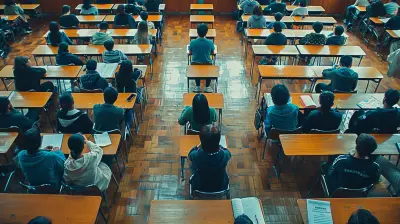How to Use Time-Outs Effectively in the Classroom
22 October 2025
Managing a classroom can sometimes feel like herding cats. Kids are curious, full of energy, easily distracted (and distractible!), and sometimes, behavioral issues come into play. That’s all part of the deal when you’re working with young minds. One of the tools many teachers use to keep things on track is the classic "time-out." But let’s be real—when used the wrong way, time-outs can feel more like punishment than support.
So, how do you use time-outs effectively in the classroom? That’s what we’re diving into here.
In this guide, I’ll break down how time-outs can be a useful part of your classroom management strategy—without turning your room into a mini prison. We’ll explore what works (and what doesn’t), when to use them, what to say, and how to make sure they actually help create a more positive learning environment for everyone.
What Is a Time-Out (Really)?
Let’s clear up a common misconception: a time-out isn’t just sticking a student in the corner or out in the hallway when they misbehave. That’s old-school, and honestly, not super effective.A time-out, when used correctly, is a chance for a student to hit pause. It gives them a moment to breathe, process what just happened, and reset. Think of it as an emotional pit stop—time to refuel and get back on track.
So, what’s the goal? It’s not punishment. It’s about teaching self-regulation and allowing students to calm down and re-engage.
Why Time-Outs Work (and Sometimes Don’t)
Here’s the deal: time-outs can be powerful, but only if they’re part of a bigger plan. Used incorrectly, they can feel humiliating or isolating to students. Used right, they help kids take ownership of their behavior and emotions.Let’s talk about the pros first:
- They give space – Some students just need a couple of minutes away from stimulation to collect themselves.
- They prevent escalation – Time-outs can stop a small issue from blowing up into a full-blown disruption.
- They promote reflection – With the right guidance, kids can actually learn something from the experience.
But here’s why they sometimes flop:
- Too vague – If students don’t know why they’re being sent or what to do while there, it’s a waste of time.
- Used too often – If you’re handing out time-outs like candy, the impact wears off.
- Feels like punishment – If the time-out is treated like a "naughty corner," kids shut down emotionally.
It’s a balancing act—but don’t worry, I’ve got you covered.
When to Use a Time-Out
Alright, so when should you actually use a time-out? Not every minor issue needs one. If a student forgets their pencil? Not a time-out situation. But if a student is disruptive, aggressive, or unable to focus due to overstimulation, then it might be time for a break.Here are a few signs it might be needed:
- Repeated interruptions during lessons
- Talking back after a warning
- Showing signs of frustration or emotional overload
- Pushing, hitting, or yelling
- Inability to follow group rules after redirection
Think of a time-out as a speed bump. You’re not stopping traffic—you’re just slowing things down so everyone stays safe and focused.
How to Set Clear Expectations
Before you start popping kids into time-out, make sure everyone knows the rules. That means laying the groundwork early—ideally at the beginning of the school year.Here’s what to cover:
- What a time-out is – Explain that it’s a tool to help them, not to punish them.- Where it happens – Choose a calm, distraction-free spot in the room—not a dark corner or out in the hallway (unless absolutely necessary).
- How long it lasts – A good rule of thumb is 1 minute per year of age. So, a 7-year-old might have a 7-minute time-out.
- What happens during – Provide something like a feelings chart, fidget toy, or a reflection sheet. This helps keep the brain engaged.
You can even roleplay time-outs during the first week. Make it part of your classroom culture: taking time to calm down is normal and healthy.
Creating a Calming Space (Not a Jail Cell)
Let’s talk about the physical setup. Your time-out area should feel like a place to regroup—not a detention center. Think cozy corner, not solitary confinement.Here’s what to include:
- A calm-down toolkit (e.g., stress balls, coloring pages, noise-canceling headphones)- A comfy seat or beanbag
- A timer
- Reflection sheets or journals
- Visual aids like emotion charts or breathing techniques
Some teachers call it the "Peace Place" or "Cool-Down Spot" to remove the stigma. Branding matters, folks!
What to Say (and What Not to)
Words matter a lot in these situations. Your tone can make or break whether a student feels supported or shamed.Try saying:
- “Looks like your body needs a break. Let’s take a few minutes to reset.”- “I can see you’re frustrated. Take some time in the cool-down space and come back when you feel ready.”
- “You’re not in trouble. This is just a moment to take care of yourself.”
Avoid saying:
- “Go sit in the time-out corner and think about what you did!”- “You’re being bad—get out of here!”
- “If you don’t behave, I'll send you to time-out again.”
See the difference? One is supportive; the other is punitive. We want students to want to rejoin the group feeling strong—not ashamed.
After the Time-Out: The Debrief Chat
A time-out doesn’t end when the timer buzzes. The follow-up conversation is where the magic happens. This is your chance to guide the student toward reflection and growth.Keep it simple and short:
- “How are you feeling now?”- “What happened before your break?”
- “What could we try next time?”
- “Are you ready to rejoin the group?”
Keep your tone calm and curious—not accusatory. This isn’t court, it’s a conversation.
And always end with a positive. “I’m glad you took some time to feel better. Let’s get back to it!”
Teaching Self-Regulation Skills
Let’s zoom out for a second. Time-outs should be just one piece of a bigger classroom management puzzle. If you want fewer time-outs over time (and who doesn’t?), help students build up their own emotional toolkits.Some simple ways to teach self-regulation:
- Use daily check-ins with emotion cards or colors- Teach belly breathing or box breathing
- Practice mindfulness minutes during transitions
- Model emotional regulation aloud (“I’m feeling frustrated right now, so I’m going to take a deep breath.”)
Think of yourself as a coach, not just a referee. The more tools students have, the less they’ll need that time-out space.
Avoiding Common Time-Out Mistakes
Let’s be honest—we’ve all made a few missteps, especially in the heat of the moment. Here are a few common time-out traps and how to dodge them:1. Overusing It
If every disruption leads to a time-out, students start to tune out. Reserve it for when a reset is truly needed.2. Using It Publicly
Announcing a time-out in front of the whole class? That’s a fast track to embarrassment and resistance. Keep it low-key and respectful.3. Skipping the Follow-Up
No check-in means no learning. Don’t skip the conversation afterward—that’s where behavior change begins.4. Being Inconsistent
Some kids get sent out, others don’t, even for the same behavior? That’s confusing and unfair. Stay consistent and clear.Time-Out Alternatives
Sometimes, a time-out isn’t the right move. That’s okay! Here are some quick alternatives:- Brain Breaks – Short physical or mental breaks
- Peer Mediation – Talking out the issue with help from classmates
- Cool-Down Cards – Let students choose a strategy from a card deck
- Redirect Attention – Use humor or distraction to shift energy
- Proactive Conferences – Talk privately before behavior escalates
The goal isn’t to discipline—it’s to guide. Sometimes the best way to help a student is a different strategy altogether.
Tracking Time-Outs (Yes, You Should)
Keep a simple log of when and why time-outs happen. Over time, patterns will emerge. Maybe the same student needs a break every day at 10:30. That could be tied to hunger, a tough subject, or a social trigger.Data helps you adjust, spot trends, and support students with tailored strategies. Plus, it’s super helpful during parent-teacher meetings or IEP reviews.
Final Thoughts: It’s About Connection, Not Control
At the end of the day, time-outs are less about "fixing" behavior and more about creating a safe space for emotional growth. When students trust that a time-out is a tool—not a punishment—they can learn to manage themselves better, not just behave better.And remember, every child is different. What works for one student might not work for another. Stay curious, stay flexible, and keep showing up with compassion.
Because let’s face it—teaching isn’t just about sharing knowledge. It’s about building humans.
all images in this post were generated using AI tools
Category:
Classroom ManagementAuthor:

Bethany Hudson
Discussion
rate this article
1 comments
Rivera Potter
Great insights on using time-outs effectively! Your strategies provide a constructive way to manage classroom behavior while promoting emotional growth. Thank you for sharing such valuable techniques for fostering a positive learning environment!
November 1, 2025 at 4:06 AM

Bethany Hudson
Thank you for your kind words! I'm glad you found the strategies helpful for promoting positive behavior and emotional growth in the classroom.


